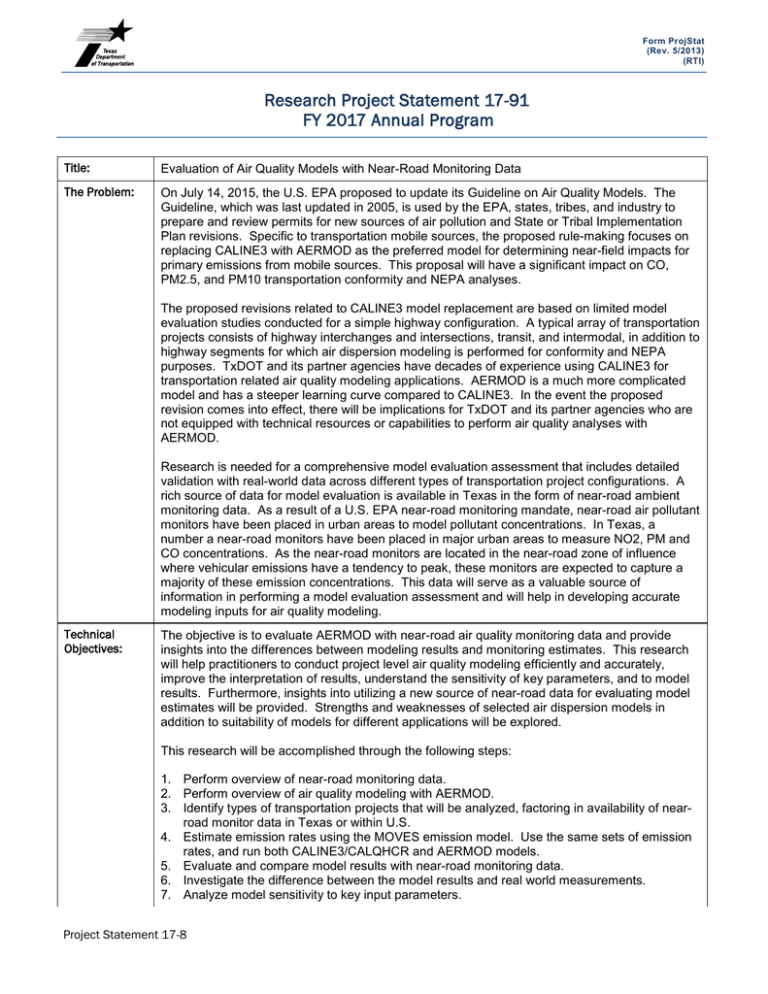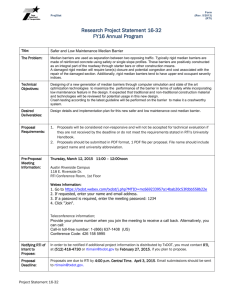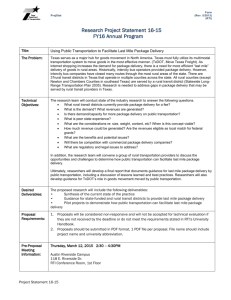Research Project Statement 17-91 FY 2017 Annual Program
advertisement

Form ProjStat (Rev. 5/2013) (RTI) Research Project Statement 17-91 FY 2017 Annual Program Title: Evaluation of Air Quality Models with Near-Road Monitoring Data The Problem: On July 14, 2015, the U.S. EPA proposed to update its Guideline on Air Quality Models. The Guideline, which was last updated in 2005, is used by the EPA, states, tribes, and industry to prepare and review permits for new sources of air pollution and State or Tribal Implementation Plan revisions. Specific to transportation mobile sources, the proposed rule-making focuses on replacing CALINE3 with AERMOD as the preferred model for determining near-field impacts for primary emissions from mobile sources. This proposal will have a significant impact on CO, PM2.5, and PM10 transportation conformity and NEPA analyses. The proposed revisions related to CALINE3 model replacement are based on limited model evaluation studies conducted for a simple highway configuration. A typical array of transportation projects consists of highway interchanges and intersections, transit, and intermodal, in addition to highway segments for which air dispersion modeling is performed for conformity and NEPA purposes. TxDOT and its partner agencies have decades of experience using CALINE3 for transportation related air quality modeling applications. AERMOD is a much more complicated model and has a steeper learning curve compared to CALINE3. In the event the proposed revision comes into effect, there will be implications for TxDOT and its partner agencies who are not equipped with technical resources or capabilities to perform air quality analyses with AERMOD. Research is needed for a comprehensive model evaluation assessment that includes detailed validation with real-world data across different types of transportation project configurations. A rich source of data for model evaluation is available in Texas in the form of near-road ambient monitoring data. As a result of a U.S. EPA near-road monitoring mandate, near-road air pollutant monitors have been placed in urban areas to model pollutant concentrations. In Texas, a number a near-road monitors have been placed in major urban areas to measure NO2, PM and CO concentrations. As the near-road monitors are located in the near-road zone of influence where vehicular emissions have a tendency to peak, these monitors are expected to capture a majority of these emission concentrations. This data will serve as a valuable source of information in performing a model evaluation assessment and will help in developing accurate modeling inputs for air quality modeling. Technical Objectives: The objective is to evaluate AERMOD with near-road air quality monitoring data and provide insights into the differences between modeling results and monitoring estimates. This research will help practitioners to conduct project level air quality modeling efficiently and accurately, improve the interpretation of results, understand the sensitivity of key parameters, and to model results. Furthermore, insights into utilizing a new source of near-road data for evaluating model estimates will be provided. Strengths and weaknesses of selected air dispersion models in addition to suitability of models for different applications will be explored. This research will be accomplished through the following steps: 1. Perform overview of near-road monitoring data. 2. Perform overview of air quality modeling with AERMOD. 3. Identify types of transportation projects that will be analyzed, factoring in availability of nearroad monitor data in Texas or within U.S. 4. Estimate emission rates using the MOVES emission model. Use the same sets of emission rates, and run both CALINE3/CALQHCR and AERMOD models. 5. Evaluate and compare model results with near-road monitoring data. 6. Investigate the difference between the model results and real world measurements. 7. Analyze model sensitivity to key input parameters. Project Statement 17-8 Form ProjStat (Rev. 5/2013) (RTI) 8. Discuss modeling requirements, data sources, input data preparation and model set-up. 9. Document current best practices. 10. Document results. Desired Deliverables: 1. Value of Research (VoR) that includes both qualitative and economic benefits. 2. Project Summary Report. 3. Research report documenting all the methodologies, data inputs, ideas to be tested and results. This document will be used to demonstrate validity and suitability of the air quality model for transportation applications. Proposal Requirements: 1. Utilize the deliverable based templates (see the University Handbook). 2. Proposals will be considered non-responsive and will not be accepted for technical evaluation if they are not received by the deadline or do not meet the requirements stated in RTI’s University Handbook. 3. Proposals should be submitted in PDF format, 1 PDF file per proposal. File name should include project name and university abbreviation. Pre-Proposal Meeting Information: Wednesday, April 20, 2016 1:30 – 2:30 PM Austin Riverside Campus 118 E. Riverside Dr. RTI Conference Room, 1st Floor Webex Information: 1. Go to https://txdot.webex.com/txdot/j.php?MTID=mfc14ab977fe5e9b0f08bd6c460e4a647 2. Meeting Number: 738 720 136 3. If requested, enter your name and email address. 4. If a password is required, enter the meeting password: 1234 5. Click "Join". Teleconference Information: Provide your phone number when you join the meeting to receive a call back. Alternatively, you can call: Call-in toll-free number: 1-866-637-1408 (US) Conference Code: 199 125 9183 Notifying RTI of Intent to Propose: Notify your University Liaison of your intent to submit a proposal. Your Liaison will provide information regarding the RFP. Proposal Deadline: Proposals are due to RTI by 4:00 P.M. Central Daylight Time, June 2, 2016. Email submissions should be sent to rtimain@txdot.gov. Project Statement 17-8




